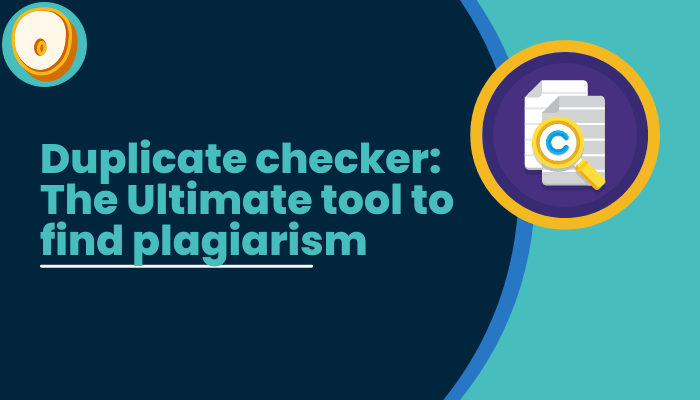Introduction
The issue of plagiarism has become a major problem due to the continuous growth and development in the digital era where all the beneficial information is easily available at our fingertips. Duplication can have quite a serious effect on damaging one’s credibility as well as reputation. To solve this major issue, the use of a trusted and reliable plagiarism checker tool has become necessary. Here we are going to explore the various important facts and significances of duplicate checkers and simultaneously we will come across how to tackle and resolve the issue of duplicate content with the help of duplicate checking tools. We will go through the terms such as features, important benefits, and various other best practices of using the plagiarism checker tool.
Check 👉 Keywords Ranking
What Plagiarism means?
In simple terms, plagiarism means the act of using someone else’s contents, ideas, or work without the proper permission or attribution. It is an unethical practice that undermines intellectual property rights and simultaneously affects the principles of academic integrity.
The Role of Duplicate Checker Tools:
Duplicate checker tools play a vital role in combating plagiarism by scanning written content and comparing it against a vast database of existing texts. These tools utilize advanced algorithms to identify similarities, matches, or instances of copied content. By highlighting potentially plagiarized sections, they provide writers with the opportunity to review and rectify any unintentional plagiarism before publication.
Features and Benefits of Duplicate Checker Tools:
Comprehensive Scanning: Duplicate checkers employ robust algorithms to thoroughly scan written content, including essays, articles, research papers, or website content. They compare the text against vast databases, including online sources, books, journals, and other publications.
Accurate Plagiarism Detection: These tools can identify exact matches, paraphrased content, and even modified or reworded text. They can pinpoint potential sources of plagiarism, ensuring a comprehensive analysis of the content.
Time-Saving: Manual detection of plagiarism can be a time-consuming and tedious task. Duplicate checkers automate the process, swiftly scanning and producing results within minutes, thereby saving valuable time for writers and educators.
Citations and References: Duplicate checkers often provide citation and reference suggestions, helping writers properly attribute sources and avoid unintentional plagiarism. This feature ensures adherence to academic and publishing standards.
Educational Tool: Duplicate checkers serve as educational resources, raising awareness about plagiarism and promoting originality in writing. They help individuals understand the importance of proper citation and the consequences of plagiarism.
Best Practices for Using Duplicate Checker Tools:
To maximize the effectiveness of duplicate checker tools, consider the following best practices:
Regular Use: Incorporate the use of duplicate checkers as part of your regular writing process. Scan your content before submission, publication, or sharing to ensure originality.
Multiple Scans: Perform multiple scans using different duplicate checker tools to enhance accuracy and reliability. Each tool may have a unique database and algorithm, increasing the chances of detecting plagiarism.
Understand False Positives: Duplicate checkers may occasionally flag content as potentially plagiarized when it is not. Understand the distinction between legitimate matches, properly cited content, and false positives to avoid unnecessary concerns.
Review and Revise: When plagiarism is detected, carefully review the identified sections and make necessary revisions. Use the opportunity to strengthen your writing by rephrasing, paraphrasing, or incorporating proper citations.
Process of checking duplicate content:
The best practice for identifying duplicate content is website auditing. But apart from this method, there are other ways to check plagiarism i.e. manual or by using some plagiarism checker website. Following are the few methods that can help you out in identifying duplicate or plagiarism content:
Content Auditing: This is one of the simplest and most effective strategies for locating duplicate content; simply copy the article from the website and paste it into the search engine (Google, Bing, Yahoo, etc.). If the content you copied is found on numerous websites on the SERP other than your copied website, it is evident that the content is duplicate content. If, on the other hand, the result just shows your website, it is apparent that the information is original and not plagiarised.
Plagiarism Checker Tool: Here identifying duplicate content is based on the plagiarism checker tool. When you paste the content on the Duplicate checker, the tool catches the content and starts crawling another website to identify similar information. After crawling various websites, if similar content is found on other websites, it means the content is plagiarised.
How to fix the duplicate content problem
Redirect 301: If you face the issue of duplicate content then 301 redirect is one of the best methods to resolve the duplicacy issue. You simply redirect the 301 page(duplicate) to the original content page.
Specify Rel=”canonical” tag: This is another option for solving duplicate content errors. Use the Rel=”canonical” tag to redirect the duplicate content page to the original one. This tag tells the search engine that specific content is a copy of these particular ULRs.
Robots Noindex Tag: The meta robots tag allows search engines to scan links on a page but does not allow them to index those links. Because Google specifically recommends against restricting crawl access to duplicate content on your website, it is vital that the duplicate page be crawled even if you ask Google not to index it. (Search engines want to see everything in case your code has errors. It allows them to make a [apparently automated] “judgment call” in otherwise ambiguous situations.)
Conclusion:
In a world where originality and integrity are highly valued, the use of a reliable duplicate checker tool is indispensable. By detecting instances of plagiarism, these tools play a crucial role in maintaining academic integrity, protecting intellectual property, and promoting ethical writing practices. By availing themselves of the features and benefits offered by duplicate checker tools, writers, educators, and professionals can ensure the authenticity and credibility of their work. Embrace the power of duplicate checkers and embark on a journey of originality, creativity, and respect for intellectual property.

